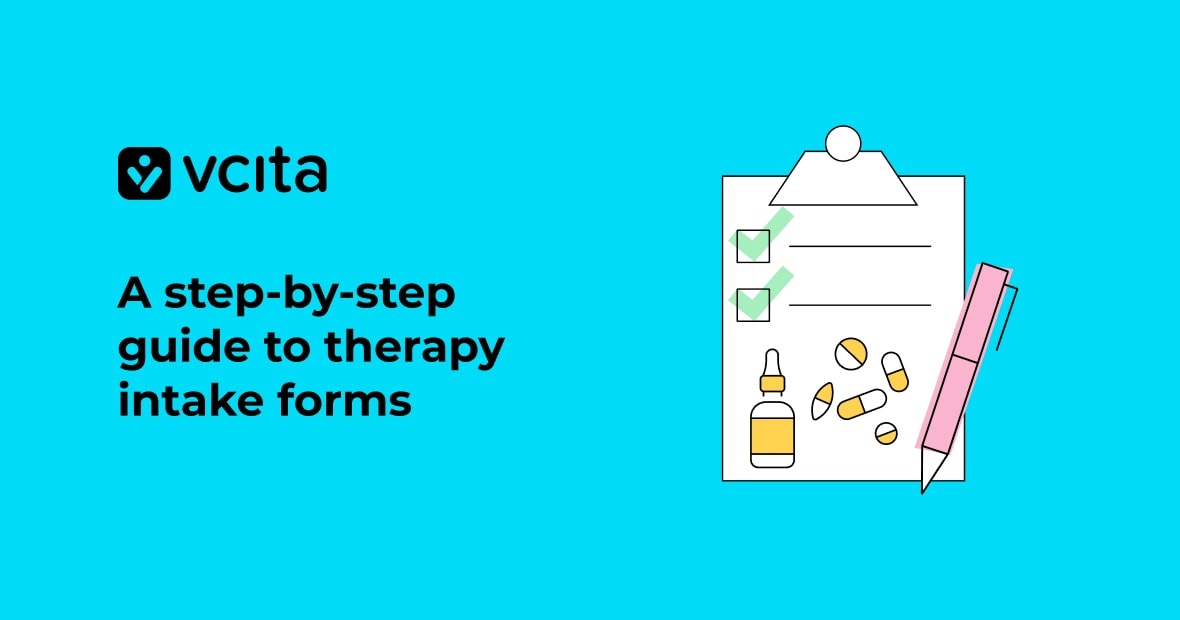Intake sessions and filling out intake forms aren’t just about information gathering. They also give your clients their first impression of your practice: how organized you are, how well you listen, and what your therapeutic orientation is. Getting intake right is one of the best things you can do for your therapy practice, because it starts your work off on the right foot.
Unfortunately, getting it right is easier said than done. It’s a delicate balance between empathic listening and information gathering—not to mention explaining your practice to your client. Most experienced therapists will tell you it’s more of an art than a science, but there are a few things you can do to help make the learning curve a little less steep.
What should happen in the intake process?
At minimum, the intake process should be an exchange of all the information both parties need to start working together. You should gather your client’s contact details, emergency contacts, mental health history, presenting concerns, and insurance information. Your client will need a rundown of your professional experience, your practice, confidentiality and its limits, and what you think the next steps are for treatment. It’s a lot—many therapists have a longer 90 minute intake session just to get everything done.
But it’s also an incredibly vulnerable moment for your client, who might be sharing something deeply personal for the first time. It takes time and finesse to maintain empathy while making sure you’ve covered all your administrative bases. One way to help your intake process go a lot more smoothly is to have a solid plan for how you’ll direct the conversation.
Here’s a rough breakdown the intake process, with some tips for each step:
1. Establishing rapport
Clients (and therapists) are often nervous in first sessions. It’s helpful to have something to break the ice—some therapists will bring clients water or tea, for example. Most therapists will briefly reiterate the concern the client expressed when booking the session, or have a short exchange about why the client has come in.
Before the discussion gets too involved, it’s a good idea to give your client an overview of your practice, especially if they haven’t been to therapy before. Nervous clients will appreciate the chance to get to know you before they dive in to their issues, but more talkative clients might need some gentle redirection. A good question for this is “Have you been to therapy before?” Once you know how familiar they are with the therapy process, you’ll know how much explaining you’ll need to do about it.
2. Creating informed consent
Informed consent means your client knows what they’re signing up for, and it’s an important part of building rapport and managing risk. Make sure you discuss your training, professional experience, and therapeutic orientation to begin to establish informed consent. It will set the tone of your practice as one of transparency and mutual respect. This means you’ll start out doing most of the talking, but it’s also a good low-stakes topic that helps establish trust.
While informed consent should be a continual practice, it’s especially important in the intake process so clients can make an informed decision about whether or not they want to continue working with you. Informed consent also means discussing fees, insurance, cancellation policies, and anything else your client might need to know about the logistics of your work together.
3. Reviewing HIPAA and the limits of confidentiality
Explaining confidentiality and your duty to report is an important part of informed consent. If you need to collaborate with other health professionals (for example, with a doctor in an inpatient program), make sure you inform the client what information you need to share. If you’re working with older children or teens, let them know what’s being communicated to their parent or guardian. Give clients paying with insurance a rundown on what you’ll share with their insurance company, and how their diagnosis might impact their insurance in the future.
It’s also a good idea to discuss your future communications in the context of HIPAA laws, particularly if you’ll be communicating via email or text. Some clients may not want notifications from their therapist to show up on their phone, so ask them what method of communication they prefer.
4. Collect signatures and emergency contact information
Make sure you have any necessary intake forms ready for your client to fill out and sign, including the consent form, intake form, and emergency contact information. If your client has had therapy in the past, this is also a good time to ask them if they’d like you to get the notes from their previous therapist. If so, they’ll also need to sign a release of information form.
Some of the more straightforward information, such as contact and emergency contact information, can be collected before the session. Consent forms should be explained to clients in person before they sign, so you can be sure they’ve understood and consented to the treatment you’re providing.
5. Perform an initial assessment
After your client is a bit more familiar with you and your practice, they’ll be more likely to feel comfortable opening up. An initial assessment is sometimes just a discussion, but diagnostic tests might be necessary if your client is paying with insurance. It’s often advisable to perform a suicide risk assessment at this stage as well, even if the client hasn’t explicitly mentioned feeling suicidal.
It can be tempting to try and pinpoint all of your client’s issues right away, but it’s usually impossible to do. Part of performing an initial assessment is accepting the fact that it may change in the future, and that assessments will be an ongoing part of therapy as you learn more about your client.
6. Map out future work
Once you have a general impression of what your client is struggling with, you can share your thoughts on what treatment might look like. Ask your client what their goals are for treatment, so you can incorporate them as well. As you learn more, the direction of treatment may change, but this will help you create a starting point for your next session.
If your client’s issues seem complex or puzzling, it may be necessary to let them know that you’ll need a few more sessions to come up with a treatment plan. If their issues are beyond the scope of your expertise, this is when you can let them know you’ll need to refer them to someone better equipped to help.
7. Discussing next steps
At the end of the session, your client should have all the information they need to decide whether or not to work with you. In the interests of consent, there should never be pressure on the client to make another session, even inadvertently. If you ask them whether they’d like to book another session with you, make sure to let them know it’s completely up to them. An alternative approach is to tell them they don’t have to decide right now, and advise them to take some time to think about it and let you know once they’ve decided.
Intake forms
Although intake forms can sometimes be a pain to fill out during a session, they’re a useful roadmap for the intake process. They’re forms that contain all the basic information about a client, and you can use them during intake sessions to help direct the conversation.
Most therapists have clients enter basic information on a simplified form before an intake session, and fill out some information during the session. If you have automated scheduling software, you can choose a few questions for your prospective clients to answer right as they schedule online. Below are a few examples of different intake forms, and what types of information they help you collect:
Basic client intake form
This intake form covers the basics. Since it’s not industry-specific, it’s useful for any service provider that has an intake process, from massage practitioners to counsellors. Basic intake forms should have the following:
- Date
- Client name
- Client request/presenting issues
- Client contact information
- Previous therapy/mental health diagnoses
Mental health practitioners can modify the “project request” and “previous work” fields to “presenting issues” and “past therapy/diagnoses” fields.
Counselling intake form
The counselling intake form contains all the fields of the basic intake form, plus some additional ones counsellors might find useful. It’s ideal for any counselling professional that wants a simple intake form designed with counsellors in mind. Here are some of the additional fields you can find in this counselling intake form:
- Emergency contact information
- Insurance information
- Payment details
- Physical health information
- Mental health information
Counsellors will need to have a separate form for informed consent signatures, but otherwise it has everything you need for a basic intake session.
Psychotherapy client intake form
The psychotherapy intake form is a bit more in-depth, with more of a questionnaire style format. It’s a guide for a more thorough biopsychosocial assessment, which is especially useful for therapists doing longer-term work. This intake form includes:
- Client contact permissions
- Mental health services and medication history
- General mental health questionnaire
- Family history
- Strengths, weaknesses, and goals
If you’re filling out the form with the client in session, it’s probably advisable to have a longer intake session to make sure you have time to go through it with them.
Psychological assessment form for adults
This assessment form is ideal for therapists working in integrated care settings, where collaboration with other medical and mental health practitioners is the norm. In addition to a more detailed health screening section, it has more fields for therapists using a community-based approach. This form includes:
- Emergency contact and referral information
- Past and current mental health providers
- Detailed medical, psychological, and family history
- Health care provider contact list
- Informed consent and cancellation signatures
Although it’s likely overkill for an individual therapist, having more detail in an integrated setting can help maintain a uniform standard of care across providers.
Medical patient intake form
This simple intake form is similar to the counselling intake form, with a medical focus instead. It’s good for chiropractors, medical clinics, or therapists using a solution-focused approach to a simple problem. It includes:
- Referral information
- Patient contact information
- Reason for the visit
- Insurance information
- Payment information
Like the counselling intake form, it doesn’t include a section for informed consent, so therapists will still need an additional form.
Medical history intake form
The main focus of this form is a detailed health assessment, with minimal contact information. It’s useful as an addendum to the medical patient intake form, or as an intake form for clinics that already have digital records in place for the basics. It has sections for:
- Allergies list
- Medications list
- Past surgical procedures
- Individual and family medical history
- Social history
It’s another form that’s ideal for integrated care settings, with more of a focus on physical symptoms than the psychological assessment form for adults.




























